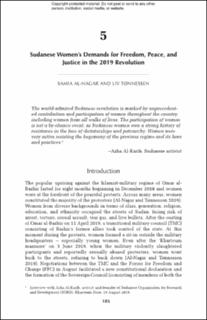| dc.contributor.author | al-Nagar, Samia | |
| dc.contributor.author | Tønnessen, Liv | |
| dc.date.accessioned | 2023-04-20T16:37:11Z | |
| dc.date.available | 2023-04-20T16:37:11Z | |
| dc.date.issued | 2021-10-01 | |
| dc.identifier | oai:www.cmi.no:7708 | |
| dc.identifier.citation | in Ladan Affi, Liv Tønnessen and Aili tripp: Women and Peacebuilding in Africa. James Currey | |
| dc.identifier.uri | https://hdl.handle.net/11250/3064103 | |
| dc.description.abstract | This chapter aims to understand why women were so visibly involved in the most recent revolution and how it relates to their struggles for peace, justice, and freedom during the dictatorship of Bashir. Women’s activism against discrimination and inequality that hamper their ability to live free of violence and contribute to society as full citizens has a long trajectory. Drawing on recent scholarship on women and the Arab spring, we argue that women’s legal and social status prior to the Sudanese revolution shaped women protesters’ demands. Drawing insights from the wider literature on why women protest, we contend that higher levels of gender discrimination and the presence of women’s organizations increase the likelihood of women’s protest. As in other revolutions in the region’s recent history, women’s participation was not spontaneous or momentary, but linked to women’s central role in defying these dictatorships | |
| dc.language.iso | eng | |
| dc.publisher | James Currey | |
| dc.relation | Women and Peacebuilding in Africa | |
| dc.relation.ispartof | Women and Peacebuilding in Africa | |
| dc.relation.ispartofseries | Women and Peacebuilding in Africa | |
| dc.relation.uri | https://www.cmi.no/publications/7708-sudanese-womens-demands-for-freedom-peace-and-justice-in-the-2019-revolution | |
| dc.subject | Sudan | |
| dc.title | Sudanese Women’s Demands for Freedom, Peace, and Justice in the 2019 Revolution | |
| dc.type | Chapter | |
